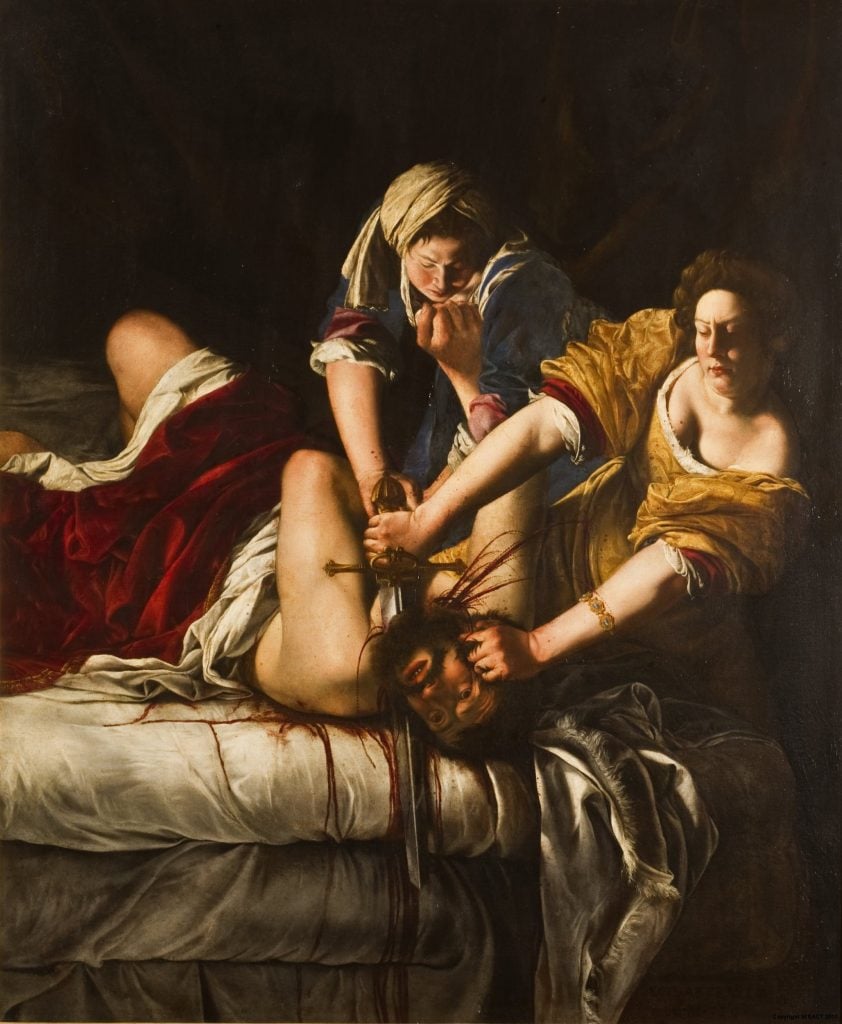Artemisia Gentileschi’s Judith Beheading Holofernes is not a painting easily forgotten. Today, the dramatic scene is among the most well-known images of the Baroque era and most art lovers are at least vaguely familiar with the painting’s autobiographical and feminist interpretations.
Gentileschi’s bloody scene was likely a commission for Cosimo II de’ Medici, the Grand Duke of Tuscany. In it, we see Judith in a darkened bedroom, dramatically slashing the throat of Holofernes, the Assyrian general, who had invaded her home city of Bethulia. Much of the popular interpretation of the scene has centered on the life of the artist, Artemisia Gentileschi (1593–1653), a remarkable woman in many regards. Daughter and student of the successful Baroque painter Orazio Gentileschi, she would become the first woman member of Florentine Accademia del Design.
But, as is commonly known, her life was marked by terrible struggle as well. Judith Beheading Holofernes is often viewed as reflecting the artist’s rape by her mentor Agostino Tassi, at the age of 17, and the grueling public trial that followed. There’s good reason for the interpretation: Artemisia used herself as the model for this particularly steely depiction of Judith, a figure often been said to embody female rage.
Still, if you dig a little deeper, this proto-feminist masterpiece is full of surprises. Here are three facts you might not know about Artemisia Gentileschi’s Judith Beheading Holofernes.
1) There’s a (Literal) Cameo by a Greek Goddess
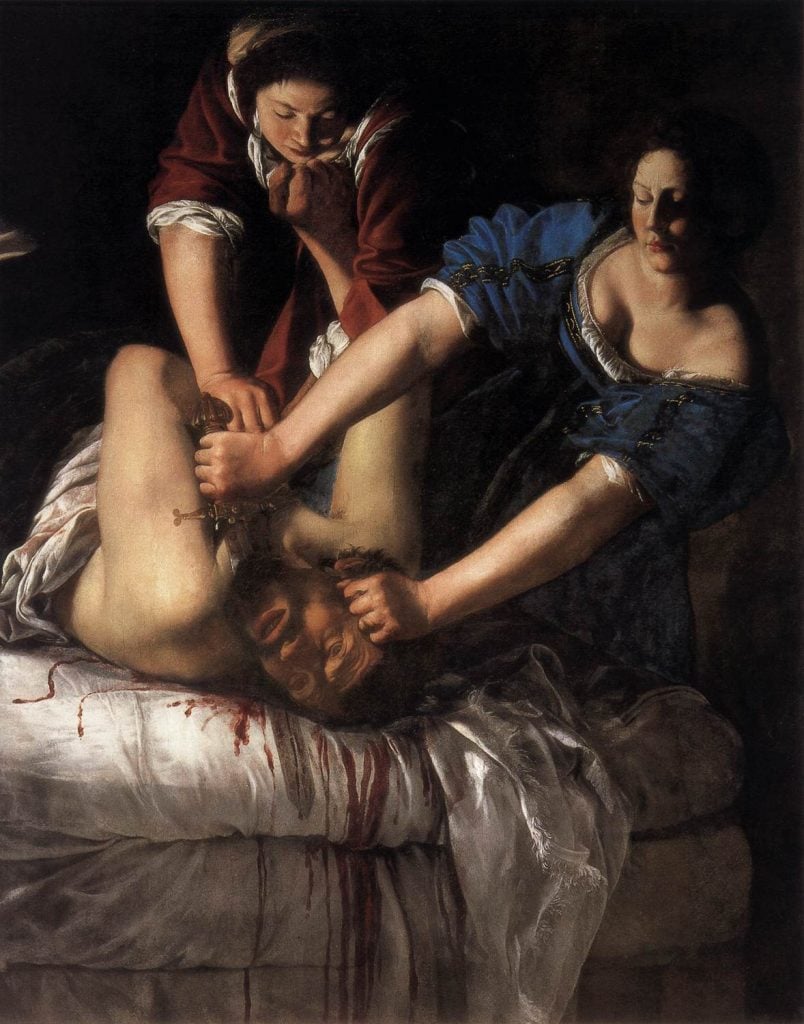
Artemisia Gentileschi, Judith Slaying Holofernes (1612–1613). Collection of Museo Capodimonte, Naples
Artemisia painted two versions of this particularly gory Judith Beheading Holofernes scene, a decade apart—along with a number of other scenes featuring Judith and Abra, her maid.
She painted the first of the two major canvasses in Rome (ca. 1611–12) when she would have been 18 or 19 years old, in the direct aftermath of her assault. Her versions of the Biblical scene are both particularly violent and particularly active in their rendering of both women.
But it’s worth keeping in mind that the graphic violence of Gentileschi’s depiction was part of a larger trend towards blood-and-guts drama in Baroque art.
Caravaggio—something of a friend of her father’s—was undoubtedly the most powerful artistic influence on Artemisia. His version of the same scene at the turn of the 17th century probably influenced her (in the 1800s, her first version would be misattributed to Caravaggio).
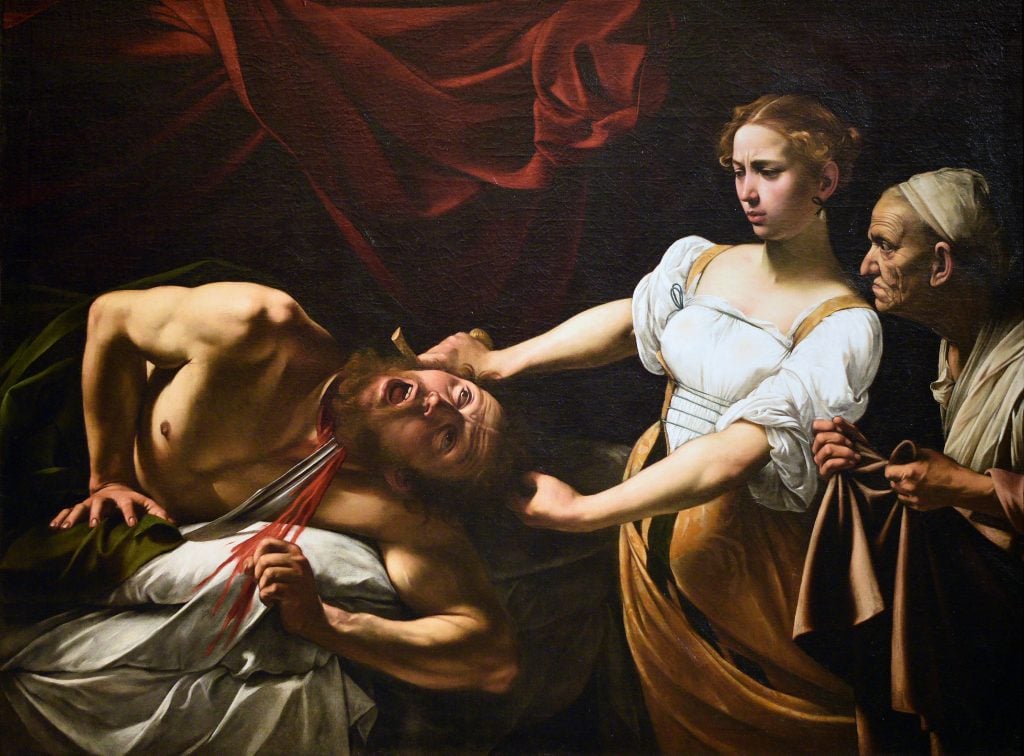
Caravaggio, Judith Beheading Holofernes (ca. 1598–1599 or 1602). Collection of the Galleria Nazionale d’Arte Antica at Palazzo Barberini, Rome.
The character of Judith, also, had a changing place in the Christian imagination that shaped the war-like quality of her depiction.
During the Medieval era, Judith was considered the Old Testament prefiguration of the Virgin Mary and thus depicted chastely and piously. During the Renaissance, with its emphasis on reclaiming classical lore, both Judith and Mary were said to be prefigured in Artemis, the Greek goddess of the hunt. Judith therefore took on a newly active quality, as a warrior.
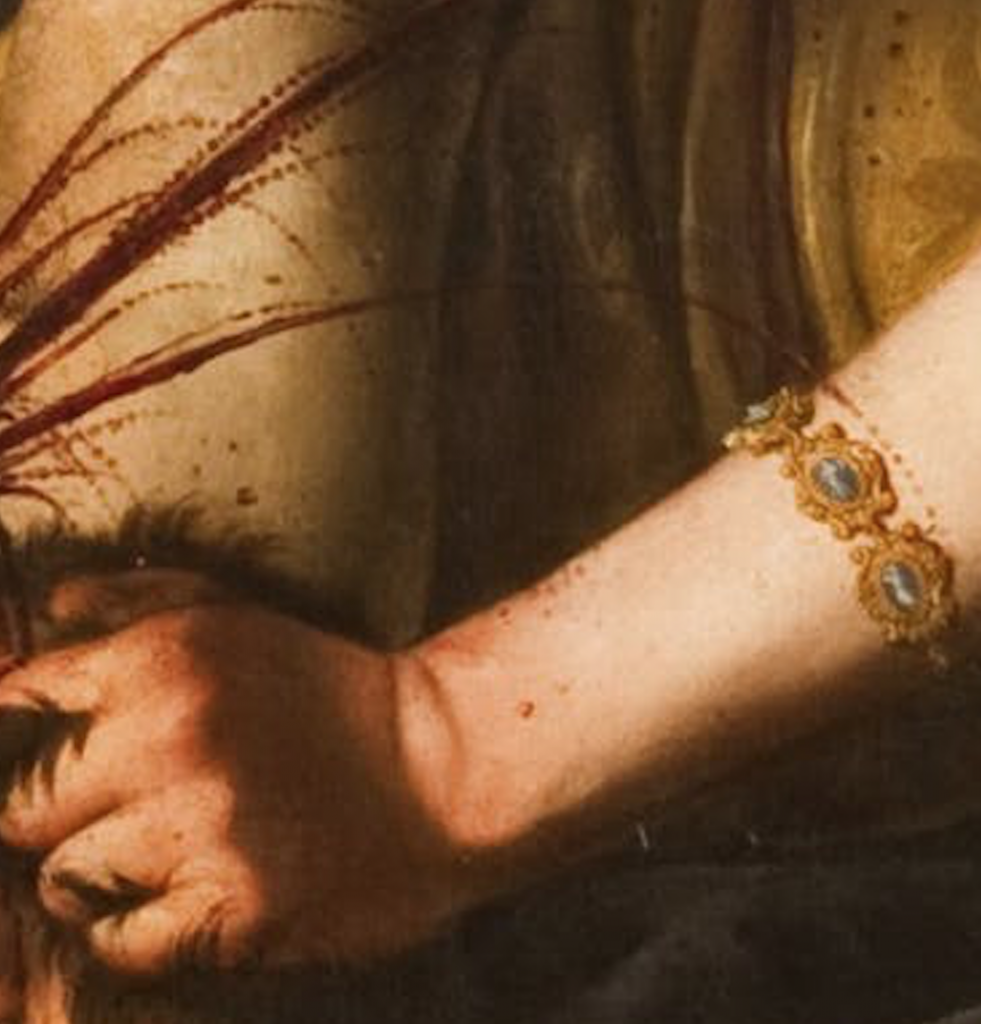
Bracelet (detail), Artemisia Gentileschi, Judith Beheading Holofernes (1620-21).
Gentileschi’s most famous depiction of the scene contains a subtle signal that she was knowingly taking advantage of this evolving, more active symbolism: the cameo bracelet on Judith’s forearm. Its tiny images are hard to make out. But in her essay “Costuming Judith in Italian Art of the Sixteenth Century,” Diane Apostolos-Cappadona makes a guess:
I want to suggest that the entire series of cameos on the bracelet are depictions of Artemis, the virgin goddess of the hunt and the moon, who is a prototype of the Virgin Mary, and an obvious reference to both Judith and to the painter. The significance of this bracelet—both in its imagery and its placement on Judith’s forearm—was signaled by the spray of Holofernes’s blood forward across Judith’s arm, creating an arc paralleling the curvature of the cameo bracelet. This placement and the cameo motifs are unique to Artemisia’s iconography of Judith.
Artemesia’s own name means “gift of Artemis.” So, to bring it full circle, it’s true that she was playing on larger trends in symbolism—but it’s hard not to see her as consciously putting her personal stamp on them.
2) All That Gore Also Represented the Church Out to Crush Its Enemies
The artist’s personal story is what stands out about this scene to a viewer today. To its 17th century viewer, what would have stood out was the political allegory.
During the Counter-Reformation, the Catholic Church turned its focus to increasingly eye-grabbing and realistic depictions of Biblical scenes in a bold campaign to reassert itself in the face of Protestantism. The image of Judith had a key place in this artistic propaganda campaign.
While Martin Luther doubted the Book of Judith’s place in the cannon, the Catholic Church seized upon it. Judith’s killing of Holofernes could easily stand as a symbol of the avenging true church striking back against foes who had wronged it. In the Book of Judith, the lines that proceed this scene doubled as a Counter-Reformation battle cry: “Standing beside the bed, Judith murmured to herself: Lord God, to whom all strength belongs, prosper what my hands are now to do for the greater glory of Jerusalem; now is the time to recover your heritage and to further my plans to crush the enemies arrayed against us.”
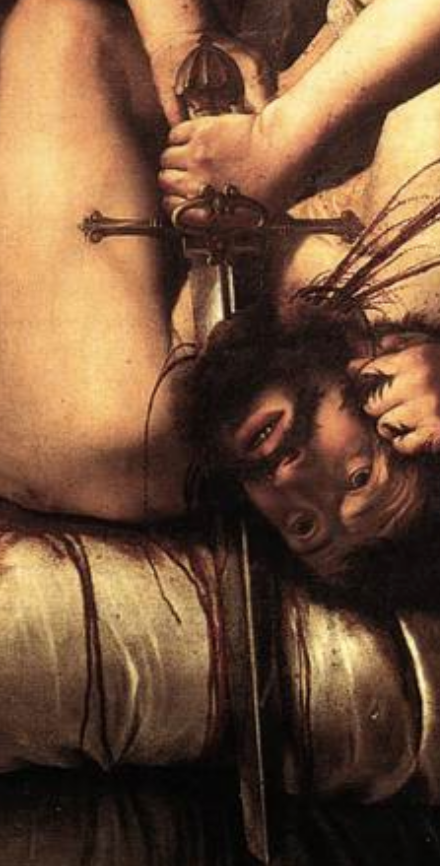
Detail of Judith Beheading Holofernes.
In the context of Italy, the protection of “heritage” came against both Protestants and the Ottoman Turks, an active presence in the Venetian State. “It must be noted that Judith’s timeliness was enhanced by the Assyrian nationality of Holofernes,” historian Elena Ciletti writes. “This assured his conflation with Islam (in the form of the encroaching Ottoman Turks), an updating of his traditional satanic characterization.”
That in mind, it is easy to read Judith’s sword at the dead center of the canvas as a Christian cross.
3) There’s Science in the Blood—Galilean Science
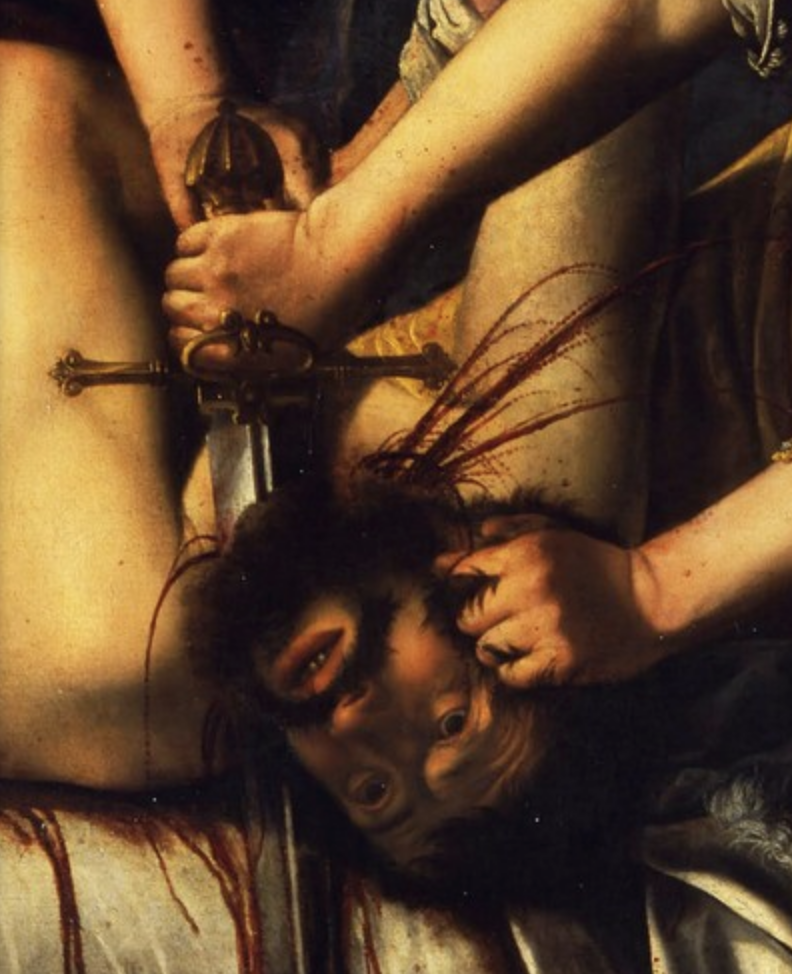
Detail of Judith Beheading Holofernes.
Gentileschi’s latter beheading painting has one big difference that makes it the splashier work (quite literally): the spectacular spurts of blood. Some have thought that their unique pattern reflects her friendship with the most famous scientist of the age: Galileo Galilei.
In the aftermath of her trial, Gentileschi moved to Florence where she lived from 1614 to 1620. There, she met the astronomer, as both were members of the Accademia del Disegno and had acquaintance with Florence’s Grand Ducal Court. By that time, Galileo had discovered the concept of “parabolic trajectory,” and had proved it mathematically (though he would not publish his findings for decades).

Galileo’s notes on parabolic trajectory.
In essence, this law of motion states that for a projectile to come to rest from a state of motion, energy must be dissipated by resistance over time, thus making it describe a parabolic arc in space. This was a new idea, and one Galileo explained graphically via drawing out the different paths that cannonballs would make as they rained down to earth—describing the same pattern that gives such a vivid quality to the blood erupting from Holofernes’s neck in Gentileschi’s indelible painting.
